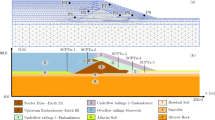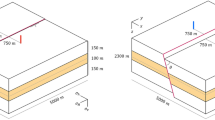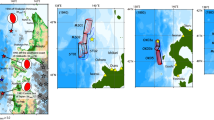Abstract
In situ stress measurements by hydraulic fracturing were carried out in the 617 m deep borehole specially drilled in the epicentral zone of the 1993 Latur earthquake for the purpose of research. The stress measurements carried out at 592 m depth in this borehole are the deepest of all such measurements made so far in the Indian shield. The maximum and minimum principal horizontal stresses (S H max andS h min) have been derived from the hydrofracture data using the classical method. TheS H max andS h min are found to be 16.5 and 9.6 MPa at 373 m depth, and 25.0 and 14.1 MPa at 592 m depth, indicating that the vertical gradients ofS hmax andS hmin in the epicentral zone are 39 MPa/km and 21 MPa/km respectively. The principal horizontal stresses in the epicentral zone are comparable with those at Hyderabad and 30% higher than in most other comparable intra-continental regions. Analysis of the results indicate that the stresses in the focal region of the 1993 Latur earthquake have not undergone any significant change following its occurrence and this is in agreement with a similar inference drawn from the seismic data analysis. It appears that the Latur earthquake was caused due to rupturing of the overpressured fault segment at the base of the seismogenic zone.
Similar content being viewed by others
References
Baumbach Met al 1994 Study of foreshocks and aftershocks of the intraplate Latur earthquake of September 30, 1993, India;Mem. Geol. Soc. India 35 33–63
Bowman J R, Gibson G and Jones T 1990 Aftershocks of the 1988 January 22 Tennant Creek, Australia intraplate earthquakes: evidence for a complex thrust fault geometry;Geophys. Int. J. 100 87–97
Cox S F 1995 Faulting processes at high fluid pressures: An example of fault valve behaviour from the Wattle Gully Fault, Victoria, Australia;J. Geophys. Res. 100 12841–12859
Gowd T N, Srirama Rao S V, Chary K B and Rummel F 1986In situ stress measurements carried out for the first time in India by hydraulic fracturing method; (Proc. Indian Acad. Sci. Earth & Planet. Sci.)95 311–319
Gowd T N, Srirama Rao S V and Gaur V K 1992 Tectonic stress field in the Indian subcontinent;J. Geophys. Res. 98 11879–11888
Gowd T N, Srirama Rao S V and Chary K B 1996 Stress field and seismicity in the Indian shield: Effect of collision between India and Eurasia;Pure and Appl. Geophys. 146 503–531
Grad M, Sarkar D, Duda S J and Kumar M R 1997 Constraints on the focal depth of the Latur earthquake of September 29, 1993, in southern India;Acta. Geophys. Polanica XLV 93–101
Gupta H Ket al 1995 Investigations of Latur earthquake of September 30, 1993;Geol. Surv. India Spl. Pub. No. 27 17–40
Gupta H K and Dwivedy K K 1996 Drilling at Latur earthquake region exposes a peninsular gneiss basement;J. Geol. Soc. India 47 129–131
Hubbert M K and Willis D G 1957 Mechanics of hydraulic fracturing;Trans. Am. Instt. Min. Engg. (AIME) 210 153–168
Mandal P, Manglik A and Singh R N 1997 Intraplate stress distribution induced by topography and crustal density heterogeneities beneath the Killari region, India;J. Geophys. Res. 102 11719–11729
Mishra D C, Gupta S B and Vyaghreswara Rao M B S 1994 Space and time distribution of gravity field in earthquake affected area of Maharashtra, India;Mem. Geol. Soc. India 35 119–126
Rajendran C P, Rajendran K and John B 1996 The 1993 Killari (Latur), central India, earthquake: An example of fault reactivation in the Precambrian crust;Geology 24 651–654
Sarma S V S, Virupakshi G, Harinarayana T, Murthy D N, Rao S P E, Veeraswamy K, Rao M, Sarma M V C and Gupta K R B 1994 A wide band magnetotelluric study of the Latur earthquake region, Maharashtra, India;Mem. Geol. Soc. India 35 101–118
Seeber L, Ekstrom G, Jain S K, Murty C V R, Chandak N and Ambruster J G 1996 The 1993 Killari earthquake in central India: A new fault in Mesozoic basalt flows?;J. Geophys. Res. 10 8543–8560
Sibson R H 1990 Conditions for fault-valve behaviour; In:Deformation Mechanisms, Rheology and Tectonics (Eds. R J Knipe and E H Rutter),Geol. Soc. (London) Spl. Publ. No. 54 15–28
Srirama Rao S V, Chary K B and Gowd T N 1998In situ stress field in the meizoseismal area of the deadly Latur earthquake of 1993;Abstract, Chapman Conference on ‘Stable Continental Region (SCR) Earthquakes’, Jan. 25–29, 1998, Hyderabad
Author information
Authors and Affiliations
Rights and permissions
About this article
Cite this article
Srirama Rao, S.V., Chary, K.B., Gowd, T.N. et al. Tectonic stress field in the epicentral zone of the Latur earthquake of 1993. Proc. Indian Acad. Sci. (Earth Planet Sci.) 108, 93–98 (1999). https://doi.org/10.1007/BF02840487
Received:
Revised:
Issue Date:
DOI: https://doi.org/10.1007/BF02840487




